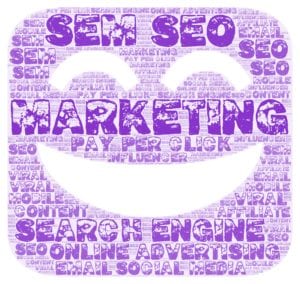
So what IS Digital Marketing? Any type of marketing for services or products that use electronic devices.
People assume Digital marketing is content marketing and social media. While these exist as types of digital marketing, they are not all encompassing. You need multiple forms of Digital Marketing for an effective marketing strategy.
Why digital marketing at all? Americans spend more than 11 hours each day using electronic devices. With the use of cell phones, tablets, and computers, digital marketing is more important and significant than ever before.
When creating your Digital Marketing strategy, review the 9 types of Digital Marketing and decide which ones fit your firm, the professional services industry, and your target audience. For most AEC firms, the first five, or some combination of them, works well.
SEO is an acronym for Search Engine Optimization. It involves techniques that boost your website on search engine results pages or SERPs. Organic (non-paid) search results happen when people search for your service or brand using search engines like Google, Bing, etc. The results are based on how the ranking algorithms of each search engine interpret the content and code of your website.
The higher you rank on a SERP, the more traffic is likely to be directed to your site and your chances increase of making a passive visitor an engaged potential client.
SEM is an acronym for Search Engine Marketing. SEM encompasses all of the techniques and strategies that are inorganic or paid advertising space on search engines. With SEM, you purchase advertisement space that appears on a user’s SERP. The most common paid search platform is Google AdWords.
Search engines charge a a predetermined amount to display an advertisement in a number of places on a SERP generated from specific keywords or phrases. One example of SEM is pay-per-click advertising or PPC. PPC refers to when a search engines charges a company each time their advertisement is clicked.
Social media platforms also support PPC advertising. Ads show up in the news feeds of a company’s target audience.
As you well know, Social Media marketing has become a strong player in getting your brand messages heard. Everything you do to increase traffic on your social media channels is social media marketing. Whether you’re on Facebook, Twitter, Instagram, or LinkedIn, these channels all support Social Media marketing tactics. B2C companies have the most to gain by listening to what their clients talk about and engaging in the conversations. It supports your firm’s credibility and when others share the posts, your reach is extended.
Email marketing allows you to update your email subscribers on a regular basis about your firm. This fosters a relationship as the email updates (for example a newsletter) provide value to your target audience. As a result, you build brand trust and brand loyalty. Frequency is not as important as consistency and value of information to the target audience.
Content marketing refers to the creation and sharing of online material that does not explicitly promote a brand but is intended to stimulate interest in its services or products.
Numerous social channels such as LinkedIn, YouTube, Twitter, and blogs use writing, images and videos to influence their audiences. Content Marketing works best when it melds together content with SEO and Social Media marketing tactics.
Affiliate marketing refers to the process of paying for conversions. Bloggers or e-commerce websites use Affiliate marketing.
Influencer marketing is where firms hire people with large social followings to promote their brand by posting one or more photos with the brand or product.
Viral marketing refers to a post of some sort that is trendy, funny, or strange enough to garner a massive amount of shares online. This causes a spike in website traffic over a short period of time.
This is basically every type of digital advertising but on a mobile device platform.

Schedule a Chat with Me
Copyright @ 2020 - Flesher Marketing Infrastructures